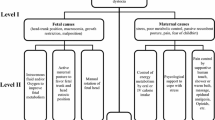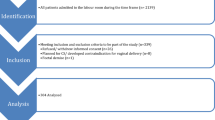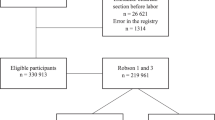Abstract
Purpose
Artificial rupture of amniotic membranes (amniotomy) which induces or accelerates labor is the most common obstetrical procedure. There is controversy about the effect of early amniotomy on dystocia and cesarean delivery. The study aim was to determine the effect of early amniotomy on the risk of dystocia and cesarean delivery in nulliparous women.
Methods
This randomized controlled clinical trial was conducted on 300 nulliparous women. They were randomly assigned into the experimental (early amniotomy; artificial amniotomy at cervical dilation ≤4 cm) and control (routine management) groups (each 150 women). Length of labor, dystocia, cesarean delivery, placental abruption, and umbilical cord prolapse were compared between the groups.
Results
Early amniotomy shortened labor duration significantly in experimental group (7.5 ± 0.7 h) compared to control group (9.9 ± 1.0 h) (P < 0.001). Dystocia (6.7 vs. 25.3 %, P < 0.0001), cesarean delivery (11.3 vs. 39.3 %, P < 0.001), and placental abruption (4.7 vs. 13.3 %, P = 0.009) were significantly lower in experimental group compared to the control group. Multiple logistic regression showed that early amniotomy decreased the odds of dystocia 80.6 % (95 % CI 58.6–90.1 %) and the odds of cesarean section 81.7 % (95 % CI 66.2–90.1 %).
Conclusion
Early amniotomy was associated with lower rate of dystocia and cesarean delivery as well as shorter duration of labor.
Similar content being viewed by others
References
Haghollahi F, Khazardoost S, Hantoushzadeh S, Naghizadeh MM, Rashidi B (2014) Induction of Labor Using Native (OXYTIP) in Comparison to Foreign Oxytocin (SYNTOCINON). J Family Reprod Health 8:53–58
Mozurkewich EL, Chilimigras JL, Berman DR et al (2011) Methods of induction of labour: a systematic review. BMC Pregnancy Childbirth 11:84
Nachum Z, Garmi G, Kadan Y, Zafran N, Shalev E, Salim R (2010) Comparison between amniotomy, oxytocin or both for augmentation of labor in prolonged latent phase: a randomized controlled trial. Reprod Biol Endocrinol 8:136
O’Driscoll K, Foley M, MacDonald D (1984) Active management of labor as an alternative to cesarean section for dystocia. Obstet Gynecol 63:485–490
Garite TJ, Porto M, Carlson NJ, Rumney PJ, Reimbold PA (1993) The influence of elective amniotomy on fetal heart rate patterns and the course of labor in term patients: a randomized study. Am J Obstet Gynecol 168:1827–1831
Rouse DJ, McCullough C, Wren AL, Owen J, Hauth JC (1994) Active-phase labor arrest: a randomized trial of chorioamnion management. Obstet Gynecol 83:937–940
Segal D, Sheiner E, Yohai D, Shoham-Vardi I, Katz M (1999) Early amniotomy—high risk factor for cesarean section. Eur J Obstet Gynecol Reprod Biol 86:145–149
Sheiner E, Segal D, Shoham-Vardi I, Ben-Tov J, Katz M, Mazor M (2000) The impact of early amniotomy on mode of delivery and pregnancy outcome. Arch Gynecol Obstet 264:63–67
Gregory KD, Curtin SC, Taffel SM, Notzon FC (1998) Changes in indications for cesarean delivery: United States, 1985 and 1994. Am J Public Health 88:1384–1387
Fraser WD, Turcot L, Krauss I, Brisson-Carrol G (2007) Amniotomy for shortening spontaneous labour. Cochrane Database Syst Rev 3:CD000015
Dilbaz B, Ozturkoglu E, Dilbaz S, Ozturk N, Sivaslioglu AA, Haberal A (2006) Risk factors and perinatal outcomes associated with umbilical cord prolapse. Arch Gynecol Obstet 274:104–107
Fraser WD, Marcoux S, Moutquin JM, Christen A (1993) Effect of early amniotomy on the risk of dystocia in nulliparous women. The Canadian Early Amniotomy Study Group. N Engl J Med 328:1145–1149
López-Zeno JA, Peaceman AM, Adashek JA, Socol ML (1992) A controlled trial of a program for the active management of labor. N Engl J Med 326:450–454
Cohain JS (2013) Amniotomy and cord prolapse. Midwifery Today Int Midwife 108:32–33
Cohain JS (2013) The less studied effects of amniotomy. J Matern Fetal Neonatal Med 26:1687–1690
Macones GA, Cahill A, Stamilio DM, Odibo AO (2012) The efficacy of early amniotomy in nulliparous labor induction: a randomized controlled trial. Am J Obstet Gynecol 207:403.e1–403.e5
Acknowledgments
The authors wish to thank Farzan Institute for Research and Technology for technical assistance.
Conflict of interest
The authors have no conflict of interest regarding this submission to report.
Author information
Authors and Affiliations
Corresponding author
Rights and permissions
About this article
Cite this article
Ghafarzadeh, M., Moeininasab, S. & Namdari, M. Effect of early amniotomy on dystocia risk and cesarean delivery in nulliparous women: a randomized clinical trial. Arch Gynecol Obstet 292, 321–325 (2015). https://doi.org/10.1007/s00404-015-3645-x
Received:
Accepted:
Published:
Issue Date:
DOI: https://doi.org/10.1007/s00404-015-3645-x




